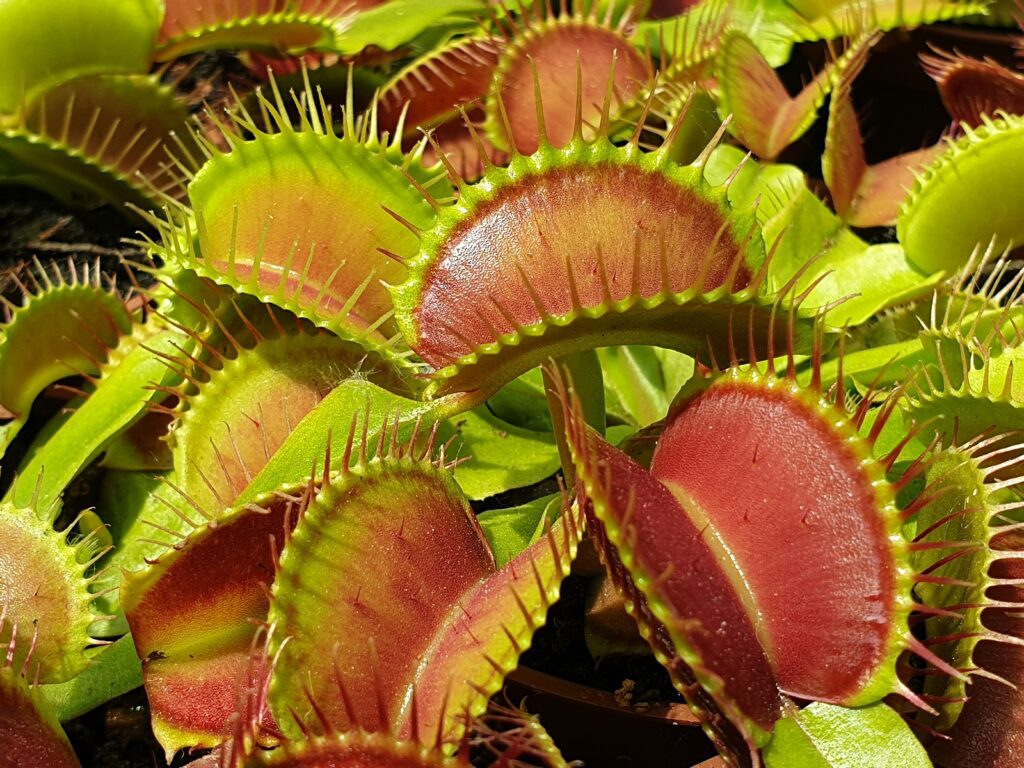Dionaea is a sub-tropical perennial bog perennial plant that feeds on insects. It is commonly grown as a houseplant in terrariums.
Dionea is rossette forming. It has rounded, yellow-green to red leaves with winged stalks. Each leaf has two hinged lobes, each with 15 to 20 stiff marginal spines and 3 or 4 sensitive hairs in the center of each lobe. Insects are attracted to the plant’s nectar. When an insect touches one of the hairs, the hinge mechanism is triggered and the leaves close trapping the insect behind the spines.
Dionea is best grown in bright light. Where insects are not available to feed the plant, it can be fed with a foliar spray.
Dionea is a genus of one plant, Dionaea muscipula. It is native to coastal bogs in North and South Carolina.
Get to Know Dionaea
- Plant type: Perennial, carniverous plant
- Growing zones and range: Zones 12-15
- Hardiness: Tender
- Optimal growing temperature: day, 60°F (16°C); night; 42° to 51°F (6° to 11°C). High humidity.
- Height and width: 6 to 18 inches (15-45cm) tall, 6 inches (15cm) wide
- Foliage: Rosette-forming, rounded, yellow-green to red leaves with winged stalks; each leaf has 2 hinged lobes with 15 to 20 stiff, marginal spines
- Flowers: Small white flowers.
- Bloom time: Late spring.
- Uses: Terrarium houseplant, bog plant
- Common name: Venus flytrap
- Botanical name: Dionaea muscipula
- Family name: Droseraceae
- Origin: Bogs in coastal North and South Carolina

Where to Plant Dionaea
- Ligh indoors: Large amount of bright light, no direct sun. Dionea does well under artificial light. Air circulation is important.
- Soil indpoors: Live sphagnum moss or recommended carnivorous mix.
When to Plant Dionaea
- Set Dionaea outdoors in subtrpical or tropical regions any time of the year.
Planting and Spacing Dionaea
- Space Dionaea 6 inches (15cm) apart.
How to Water and Feed Dionaea
- Water: Keep growing medium constantly wet, not soggy. Mist Dionaea daily; it prefers humidity of 60% to 65%.
- Feeding: When Dionaea is fully mature it appears pink. A mature plant can be given small insects of use a light foliar spray of seaweed emulsion, diluted to 1/16 strength; or 1 drop gelatin-water solution. Avoid overfeeding Dionaea. Feeding once a week during spring and summer with a balanced, water-soluble fertilizer is sufficient.
Dionaea Care
- Dionea enters dormant period in winter when foliage dies back. Remove dried leaves. Reduces water; keep rhizomes in refrigerator for to 2 to 3 months.
Growing Dionaea as a Houseplant
- Dionaea needs bright light, cool temperature, high humidity, and a constantly moist growing medium. It will grow well in a terrarium.
- The planting medium of sphagnum moss is closest to its natural growing condition.
- If Dionaea does not catch insects, it should be fertilized once a week during spring and summer with a balanced, water-soluble fertilizer.
Dionaea Pests and Diseases
- Venus flytrap is not susceptible to damage by insects, since it consumes then; but it can develop powdery mildew. Check for aphids, fungus, mealybugs, scale.
Dionaea Propagation
- Dionaea propagation is by cuttings, division or seeds.
- Division of underground bulbs is best done in spring.
- Seed germination is very slow.
Dionaea Varieties to Grow
- Dionaea muscipula, Venus flytrap. Rosette-forming perennial wit rounded, yellow-green to red leaves with winged stalks; each leaf has 2 hinged lobes with 15 to 20 stiff, marginal spines that hold insects captive when the trap snaps shut; white flowers are produced in late spring.



